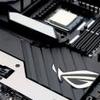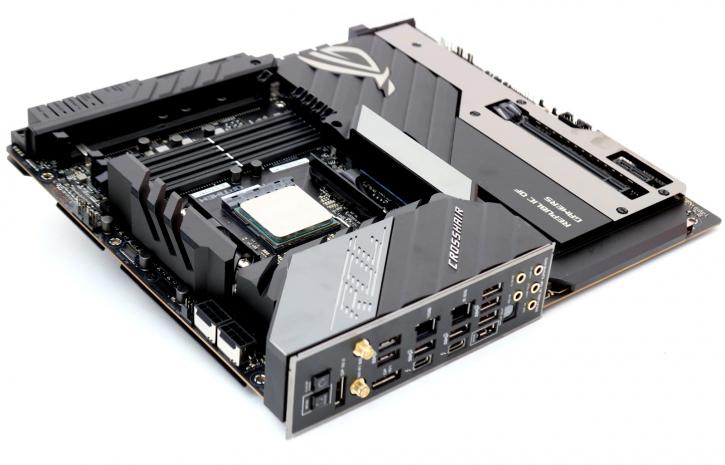Final Words & Conclusion
Final Words
So yes, an 800 USD motherboard is not faster than a 200 USD one, however it's all about features. What a stunningly beautiful motherboard, eh? The VIII Extreme has a sleek, high-end appearance, and it fits sweetly into this category. It's a beast of a creature, and then some. ASUS employed only high-quality components in this build and continued to add features such as 2.5 and 10 Gigabit connectors and a pretty sweet WIFI6E (AX) network solution. By the way, our AC wifi test results were good, not perfect, with a throughput of ~600 Mbit/s on a single link. It's a good achievement though. It is exactly the same with the threefold of M2 slots, which are, by the way, appropriately cooled and then the extra 2 through the DIMM2 slot. I truly adore this motherboard just for the looks and features. However, prices do pose a massive issue. Currently this board is listed at 800 EUR with roughly similar prices in USD, OMG.
DDR4 Memory
Memory compatibility should not and likely will not be an issue as long as you stick to recently released DIMMs. I'll keep repeating this, but there are some really good Ryzen optimized kits out there. With Ryzen Generation 3, you can go higher in DDR4 clock frequency if you want to. The mobo can manage ~5000 MHz - We advise you to use up to 3600 MHz; CL16 is fine and CL14 sweet; after that frequency value, a 2:1 divider kicks in, and that can affect the Infinity Fabric bandwidth, inter-core CCX bandwidth. We see no reason for faster DDR4 memory anyway; it's expensive and does not bring in added perf, much like what you see on Intel platforms as well. On Ryzen 5000, the Infinity fabric (interlink) runs slightly faster. There 4000 MHz could become a new norm.
Energy efficiency
With these processors now fabbed at 7nm, you may see some interesting energy efficiency; the roughly 75 Watts for the 5900X is, of course, fine all by itself. Mind you, these are numbers at a nominal load. Not your continuous power draw. Overall the 5900X was idling a bit higher than expected, but that is likely due to the massively outfitted motherboard (extra ICs do use extra power). The load values are fine as our 5900X reached 232 Watts with stress on all 24 threads.
Overclocking
Depending on your objectives, there are numerous approaches to overclock an AMD platform. If your primary concern is single-threaded performance, you may want to concentrate on utilizing and tweaking Precision Boost Overdrive (PBO). If all cores and threads are available, manually changing the CPU multiplier and voltage is generally the superior option. While the latter somewhat reduces peak single-threaded performance, it more than compensates by increasing all core/thread performance. To that end, we settled on a 4.4 GHz all-core/thread overclock of 1.3V. The Crosshair VIII Extreme easily overclocked our Ryzen 9 5900 with 12 cores and 24 threads to ~4600 MHz allcores. We set LLC to the Asus recommended Turbo setting (Level 4), established a fixed voltage of 1.325V, and took off with minimal vdroop. The lack of vdroop was expected, because the X570 platform's eighteen 18-phase 90A power delivery is the most robust we've observed. On the memory front, we know AMD is limited to about 3600/3733 MHz while maintaining a 1:1 FCLK to RAM ratio. In light of this, we add two additional sticks and run 4x8GB at DDR4 3600, AMD's current sweet spot. We encountered no issues, although the board defaulted to a 1:2 memory ratio out of the package. However, we then changed it to 1:1 and it worked flawlessly. I'd prefer to see this board default to a 1:1 ratio for DDR4 3600, but that's a minor quibble. The results will vary per processor.
The conclusion
Really, you can't associate this motherboard to any other X570 motherboards available. When compared to other affordable X570 motherboards, you'll see a little increase in performance, but it won't be significant enough to justify the higher price tag on this model. Who's this mobo for? Well, for those looking for high-end and extreme features, the Crosshair series from ASUS is a great choice. Multiple M.2 slots, amazing water-cooling support, overclocking assistance, a more efficient power delivery setup, USB ports (including Thunderbolt 4), OLED display, physical buttons for BIOS switching, and both 10G and 2.5G LAN connections are all available to you on this motherboard. The problem is that most PC builds will not necessitate the use of any of these functions. Most gamers do not build their own water-cooling loops, nor do they require the ability to connect up to five M.2 SSDs to their computer system. The VIII Extreme however offers a super-strong foundation for an enthusiast build or for a creator PC, depending on your preferences. The answer to the question "should you buy this motherboard?" boils down to how much money you have to spend on it and what requirements you really need. The Crosshair VIII Extreme, with its predominantly dark and somewhat menacing design, as well as its bright and subtle RGB implementation, can quickly become the focal point of your gaming setup. In this high-end market, most of the big board partners are up against stiff competition. MSI offers the MEG X570 Godlike ($699.99) and Gigabyte has the X570 Aorus Xtreme ($650), all of which have been available from the day they were released. All of these motherboards have overbuilt power delivery and are capable of handling an up-to Ryzen 9 5950X processor under any conditions. However, only the Asus M.2 storage device supports a total of five M.2 devices. Due to the fact that it is new, the Crosshair VIII Extreme takes advantage of this by using the most up-to-date audio codec and integrated Wi-Fi 6E technology, as opposed to the others that have been around for a while and so employ last-generation audio and Wi-Fi 6. While neither of these features will be a deal-breaker for the majority of consumers, they may help to sustain the price point of the Gigabyte and MSI models. Having the latest and greatest may be more significant than the actual real-world benefits if you're searching for a board of directors of this quality, but we won't pass judgment on that. For those looking for the greatest performance out of the X570 platform, go no further than the ROG Crosshair VIII Extreme motherboard. This board has everything you could ever want in a flagship-class component thanks to its strong VRMs and cutting-edge features. If you're looking for an X570 motherboard and have a budget of $800, the ROG Crosshair VIII Extreme could be at the top of your shortlist.
- Sign up to receive a notification when we publish a new article
- Or go back to Guru3D's front page.



